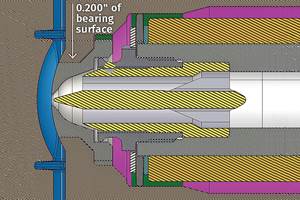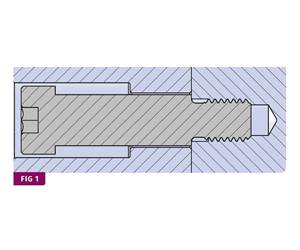You Think You Know Your Molds? Try These 10 Questions to Find Out for Sure
A mold repair technician’s job has always been to make molds run—anyhow, any way.
A mold repair technician’s job has always been to make molds run—anyhow, any way. Intangibles such as technique, methodology, maintenance efficiency, accountability, and continuous improvement have never been much of a factor in assessing the performance of a custom repair facility, a proprietary mold repair shop, or an individual’s skill level. Performance was based on missed production schedules…period. Today, however, any company seeking to sharpen its competitive edge realizes that keeping molds production-ready and reliable is much more dependent upon proactive maintenance measures than reactive habits.
To implement an accurate, efficient repair and to optimize downtime hours, repair technicians must have access to data that lets them quickly evaluate the mechanical and performance characteristics of any mold on which they work. Repair technicians should not be expected to recall from memory data relating to specific issues of maintaining and troubleshooting a stable of expensive molds. To do the job effectively, they need to know not only the smallest details such as minuscule tolerances and stack dimensions, but also the predominant long-term issues molds suffer as a result of design or construction features that cause problems during production or maintenance.
In today’s economy, it is becoming more common for the customer to be asking these questions of their mold vendors, because they want to know exactly what is going on with their half-million-dollar mold and how their repair dollars are being spent.
Still, many shop supervisors feel that if nothing is broken right now…then all is well. But to make continuous improvements in mold maintenance and repair, the supervisor must be able to measure performance, and then set targets and goals for molds and personnel.
I am often asked what are the most important areas of mold performance and the maintenance criteria to be used by repair technicians, managers, supervisors, and customers. Here are 10 questions that will demonstrate the current level of data utilization in your company, in terms of data that is readily available for a repair technician, supervisor, manager, or engineer to use on a daily basis. The answers to the first three questions are critical for any hope of improvement and are needed to determine targets and set goals. If you can’t answer the first three, you needn’t continue on, because the following questions just drill deeper into your mold knowledge database.
1. What is your #1 reason for unscheduled mold downtime and what is the cost?
a. What is the total count and type of the most common unscheduled mold-stop reason?
b. What is the mold distribution for the #1 unscheduled mold stop reason? (Is it related to a particular mold style, product, or press?)
c. What is the time and personnel correlation with the #1 unscheduled mold stop reason?
d. What are the related corrective actions and costs (of tooling and labor) for resolving the #1 unscheduled mold-stop reason?
2. What is your #1 mold or part defect or quality issue?
a. What is the total count and type of that defect?
b. What is the mold distribution of the defect? (Mold style, product, or press related?)
c. What is the cavity I.D. or mold position of the defect? (Is it position related?)
d. What are the related corrective actions and costs (tooling and labor) for resolving the defect?
3. Which is your mold with the highest maintenance costs (per hour or cycles of run time)?
a. What is the mold description, style, and product?
b. What are the types of defects and frequencies for that mold?
c. What type of tooling is used by that mold?
d. What type of corrective actions are required for that mold (cleaning, replacement, reworking, restacking, shimming, etc.)?
e. What are the related corrective actions and costs (tooling and labor) for that mold?
Answers to the next three questions provide data for supervisors to better schedule mold repairs and match repair skills to job complexity—i.e., optimize downtime hours.
4. What are the average repair hours for each mold during the following:
a. Wipe-down level cleaning (level 1)?
b. General level cleaning (level II)?
c. Major level cleaning (level III)?
5. What is the workload of each of your mold technicians?
a. How many molds does each repair?
b. What types of molds does each repair—i.e., mold styles, products (a measure of repair skill)?
c. What is each technician’s mold-repair efficiency? Do their molds always start up with 100% efficiency and no quality or production issues?
d. What are the average corrective action costs (labor and tooling) for each technician?
6. What is the total workload and mold-repair pace of your shop?
a. What is the total count of molds repaired?
b. What types of molds are repaired (mold styles, products)?
c. What are the average labor hours per repair?
The next four questions provide supervisors and technicians the necessary data to look farther down the road to recognize and monitor trends and patterns so as to budget more wisely.
7. What are your top 10 molds with the most unscheduled downtime events?
a. What are the types and frequencies of unscheduled mold-stop reasons?
b. What is the mold distribution for the unscheduled mold-stop reasons (mold style, product, or press related)?
c. What is the time and personnel correlation with the unscheduled mold-stop reasons?
d. What are the related corrective actions and costs (tooling and labor) for resolving the unscheduled mold-stop reasons?
8. What are your top 10 mold or part defects overall?
a. What are the defect types and frequencies?
b. What is the distribution of the defects (mold style, product, or press related)?
c. What is the cavity I.D. or mold position of defects (position related)?
d. What are the related corrective actions and costs (tooling and labor) for resolving the defects?
9. What are your top 10 molds with the highest overall defect count?
a. What are the defect types and frequencies?
b. What is the mold distribution of the defects (mold style, product, or press related)?
c. What is the cavity I.D. or mold position of defects (position related)?
d. What are the related corrective actions and costs (tooling and labor) for resolving the defects?
10. What are the top 10 molds with the highest maintenance costs (per hour or cycles of run time)?
a. What are the mold descriptions, styles, and products?
b. What are the defect types and frequencies?
c. What types of tooling are used by these molds?
d. What types of corrective actions are required (cleaning, replacement, reworking, restacking, shimming, etc.)?
e. What are the related corrective actions and costs (tooling and labor)?
About the Author
Steven Johnson is the maintenance systems manager for Progressive Components and has his own business, MoldTrax, in Ashland, Ohio. He can be reached at steve@moldtrax.com or (419) 289-0281.
Related Content
Hot Runners: Truths. Myths, Overlooked Areas: Part 2
Here’s a view from the trenches of a tooling manager who, over 30 years, has experienced the joys and pains of using virtually every type of hot runner on the market. Part 2.
Read MoreWhy Shoulder Bolts Are Too Important to Ignore (Part 2)
Follow these tips and tricks for a better design.
Read MoreHow to Start a Hot-Runner Mold That Has No Tip Insulators
Here's a method to assist with efficient dark-to-light color changes on hot-runner systems that are hot-tipped.
Read MoreHow to Design Three-Plate Molds: Part 2
There are many things to consider, and paying attention to the details can help avoid machine downtime and higher maintenance costs, and keep the customer happy.
Read MoreRead Next
People 4.0 – How to Get Buy-In from Your Staff for Industry 4.0 Systems
Implementing a production monitoring system as the foundation of a ‘smart factory’ is about integrating people with new technology as much as it is about integrating machines and computers. Here are tips from a company that has gone through the process.
Read MoreSee Recyclers Close the Loop on Trade Show Production Scrap at NPE2024
A collaboration between show organizer PLASTICS, recycler CPR and size reduction experts WEIMA and Conair recovered and recycled all production scrap at NPE2024.
Read MoreFor PLASTICS' CEO Seaholm, NPE to Shine Light on Sustainability Successes
With advocacy, communication and sustainability as three main pillars, Seaholm leads a trade association to NPE that ‘is more active today than we have ever been.’
Read More





















